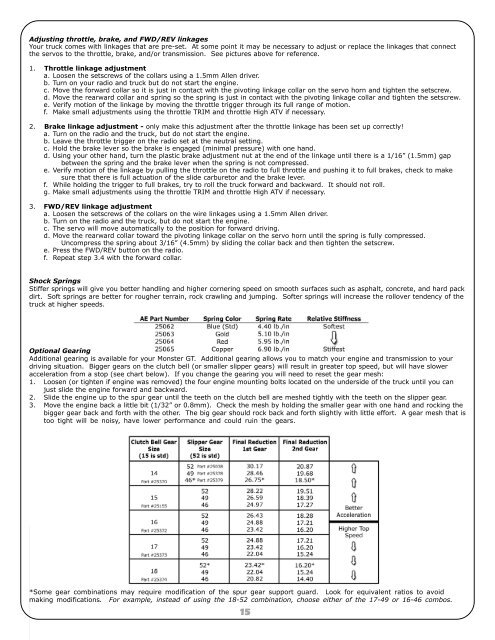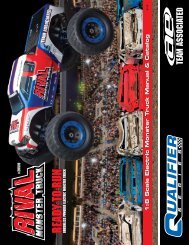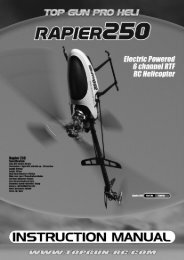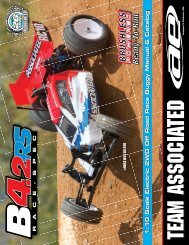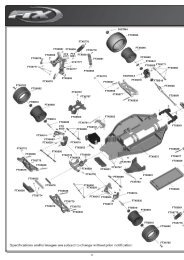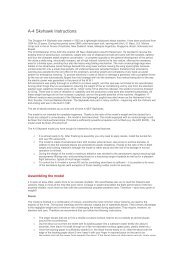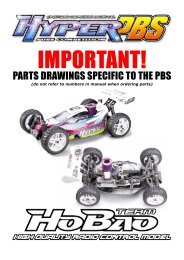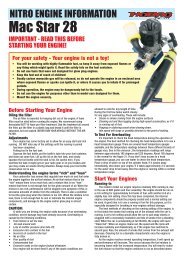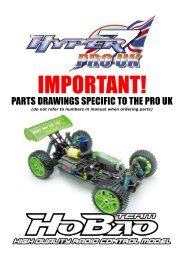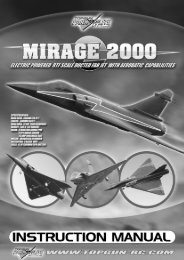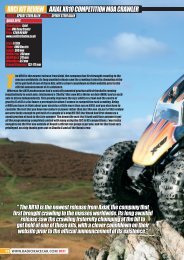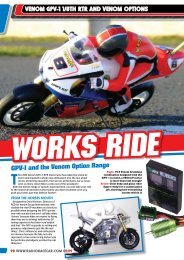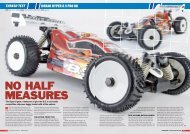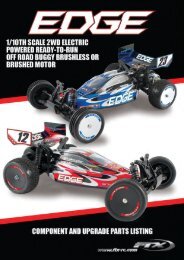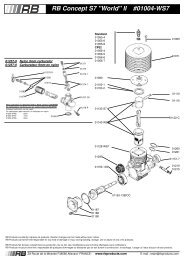Team Associated MGT 4.6 - Manual - Arrow Models
Team Associated MGT 4.6 - Manual - Arrow Models
Team Associated MGT 4.6 - Manual - Arrow Models
Create successful ePaper yourself
Turn your PDF publications into a flip-book with our unique Google optimized e-Paper software.
Adjusting throttle, brake, and FWD/REV linkages<br />
Your truck comes with linkages that are pre-set. At some point it may be necessary to adjust or replace the linkages that connect<br />
the servos to the throttle, brake, and/or transmission. See pictures above for reference.<br />
1. Throttle linkage adjustment<br />
a. Loosen the setscrews of the collars using a 1.5mm Allen driver.<br />
b. Turn on your radio and truck but do not start the engine.<br />
c. Move the forward collar so it is just in contact with the pivoting linkage collar on the servo horn and tighten the setscrew.<br />
d. Move the rearward collar and spring so the spring is just in contact with the pivoting linkage collar and tighten the setscrew.<br />
e. Verify motion of the linkage by moving the throttle trigger through its full range of motion.<br />
f. Make small adjustments using the throttle TRIM and throttle High ATV if necessary.<br />
2. Brake linkage adjustment - only make this adjustment after the throttle linkage has been set up correctly!<br />
a. Turn on the radio and the truck, but do not start the engine.<br />
b. Leave the throttle trigger on the radio set at the neutral setting.<br />
c. Hold the brake lever so the brake is engaged (minimal pressure) with one hand.<br />
d. Using your other hand, turn the plastic brake adjustment nut at the end of the linkage until there is a 1/16” (1.5mm) gap<br />
between the spring and the brake lever when the spring is not compressed.<br />
e. Verify motion of the linkage by pulling the throttle on the radio to full throttle and pushing it to full brakes, check to make<br />
sure that there is full actuation of the slide carburetor and the brake lever.<br />
f. While holding the trigger to full brakes, try to roll the truck forward and backward. It should not roll.<br />
g. Make small adjustments using the throttle TRIM and throttle High ATV if necessary.<br />
3. FWD/REV linkage adjustment<br />
a. Loosen the setscrews of the collars on the wire linkages using a 1.5mm Allen driver.<br />
b. Turn on the radio and the truck, but do not start the engine.<br />
c. The servo will move automatically to the position for forward driving.<br />
d. Move the rearward collar toward the pivoting linkage collar on the servo horn until the spring is fully compressed.<br />
Uncompress the spring about 3/16” (4.5mm) by sliding the collar back and then tighten the setscrew.<br />
e. Press the FWD/REV button on the radio.<br />
f. Repeat step 3.4 with the forward collar.<br />
Shock Springs<br />
Stiffer springs will give you better handling and higher cornering speed on smooth surfaces such as asphalt, concrete, and hard pack<br />
dirt. Soft springs are better for rougher terrain, rock crawling and jumping. Softer springs will increase the rollover tendency of the<br />
truck at higher speeds.<br />
Optional Gearing<br />
Additional gearing is available for your Monster GT. Additional gearing allows you to match your engine and transmission to your<br />
driving situation. Bigger gears on the clutch bell (or smaller slipper gears) will result in greater top speed, but will have slower<br />
acceleration from a stop (see chart below). If you change the gearing you will need to reset the gear mesh:<br />
1. Loosen (or tighten if engine was removed) the four engine mounting bolts located on the underside of the truck until you can<br />
just slide the engine forward and backward.<br />
2. Slide the engine up to the spur gear until the teeth on the clutch bell are meshed tightly with the teeth on the slipper gear.<br />
3. Move the engine back a little bit (1/32” or 0.8mm). Check the mesh by holding the smaller gear with one hand and rocking the<br />
bigger gear back and forth with the other. The big gear should rock back and forth slightly with little effort. A gear mesh that is<br />
too tight will be noisy, have lower performance and could ruin the gears.<br />
*Some gear combinations may require modification of the spur gear support guard. Look for equivalent ratios to avoid<br />
making modifications. For example, instead of using the 18-52 combination, choose either of the 17-49 or 16-46 combos.<br />
15


